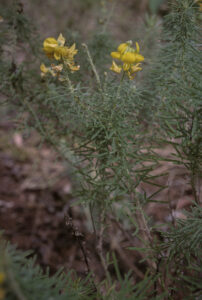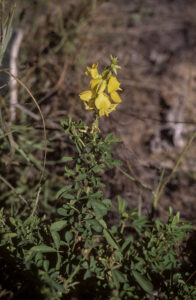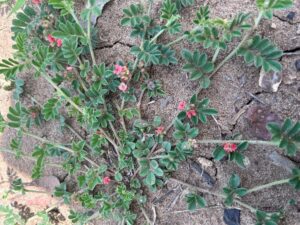Poisonous plants in Queensland’s north west
Key points
- Toxic plants become hazardous when they become the dominant plant growing in a pasture, often occurring during droughts or the dry season.
- Problems often occur when light rain stimulates growth of the poisonous plants and follow-up rain is not enough to stimulate the growth of other pasture species.
- A lack of alternative palatable feed is the major contributing factor to increasing the risk of horses and other livestock consuming poisonous plants.
- Knowing which poisonous plants are in your area can help you be aware of symptoms, periods of greatest risk and management strategies.
There are around 36 species of crotalaria, commonly known as ‘rattlepods’, native or naturalised in northern Australia, and several indigofera species.
This article focuses on those found in North West Queensland and will discuss:
- The cumulative damage of crotalaria poisoning complicates diagnosis
- Chillagoe horse poison
- Walkabout disease
- Non-poisonous crotalaria species
- Birdsville disease caused by grazing indigofera
- Managing risks
- Preventative pasture management
Cumulative damage from crotalaria complicates diagnosis
With cumulative and chronic liver damage resulting from grazing certain crotalaria plants, the delayed onset of symptoms can be several months after horses have grazed these toxic plants.
Symptoms are often observed as late as the following wet season when grazing of these toxic plants may have occurred months prior to obvious disease onset.
Late onset of symptoms can create challenges with identifying the toxic plants responsible for the disease as the associated grazing may have occurred much earlier in the season, or at a different location (e.g. yards or other holding paddocks etc).
By the time disease symptoms are obvious, the offending plants may no longer be obvious due to changes in the plant making them harder to identify, or they may not be present at all, creating additional challenges with disease confirmation.
Consumption of these plants is frequently associated with pyrrolizidine alkaloid poisoning which leads to diseases commonly referred to as Kimberley horse disease or walkabout disease and oesophogeal ulceration known as Chillagoe horse poisoning disease.
Internal ulcers a sign of Chillagoe horse poison

The species that are associated with Chillagoe Horse Poisoning are Crotalaria aridicola (Chillagoe horse poison) and Crotolaria medicaginea (trefoil rattlepod). Grazing of these plants can cause oesophageal ulceration and severe upper stomach ulceration in horses.
The risk of this disease occurring is highest after rain produces a flush of growth of these plants. Horses are known to readily graze these plants, particularly where alternative sources of quality forage are lacking.
A newly recognised form of this species was found to be responsible for causing Kimberley Walkabout Disease poisoning of horses in the Longreach area in 2010. These plants contain a different pyrrolizidine alkaloid, known as cromedine. At this stage, this variety can only be conclusively identified by its distinct chemical profile following laboratory testing.
Walkabout disease affects most livestock

Walkabout disease is caused by Crotalaria crispata and Crotalaria retusa species – both identified in parts of North West Queensland. When grazed, the pyrrolizidine alkaloid toxin accumulates over time, slowly causing liver damage in the animal until it becomes evident as an illness.
The disease may occur in ruminants, pigs, poultry and horses.

Signs of the disease can include:
- reduced food intake
- jaundice
- colic
- abdominal swelling
- nervous signs such as twitching, manic and aggressive behaviour when handled, blindness, compulsive walking and sudden death.
Horses affected by walkabout disease show similar symptoms to cattle but can also experience paralysis of the tongue and larynx, leading to breathing difficulties.
Identification is key

Trefoil rattlepod (Crotalaria medicaginea) is a native leguminous species growing predominantly in Mitchell grass pastures of North West Queensland. Its growth is prolific, reproducing easily each season. When conditions are favourable, the plant can germinate more quickly than others and ‘beats them out of the blocks’ to become the dominant plant. This is especially noticeable on country where the health of perennial grasses has been affected by drought, flood, or overgrazing.
Crotalaria medicaginea var. neglecta can grow to one metre tall with pods 4-6 millimetres in length. This variety is not yet to be indicated to cause poisoning of cattle or sheep, however, has been observed to be toxic to horses. It contains an unidentified toxin that elicits ulceration of the oesophagus, preventing swallowing of water or food.
Meanwhile, Crotalaria medicaginea var. medicaqinea is shorter (growing to around 30 centimetres), with pods only 3-4 millimetres long.
Not all crotalarias have been tested for their individual toxic contents.
Indigofera linnaei causes Birdsville disease
Birdsville indigo (Indigofera linnaei) is another native legume that is toxic to livestock and has a widespread distribution across northern and central Australia. Indigofera linnaei contains contains 2 toxins – the liver toxin indospicine and the neurological toxin 3-nitropropionic acid (3-NPA). In pastures where this species is dominant (that is, greater than 25%), the risk of poisoning is high.

The nervous system signs in horses associated with Birdsville disease are caused by 3-NPA, which is released during the digestion of I. linnaei and is rapidly absorbed in the large intestine.
When ruminants consume I. linnaei, 3-NPA is metabolised and detoxified in the rumen. As such, these animals do not absorb it and remain unaffected.
Meanwhile, after only 2-4 weeks of grazing indigofera, horses can develop symptoms such as acute ataxia (abnormal, uncoordinated movements), toe dragging and muscle wasting.
Supplementing horses that may be impacted with the amino acid, arginine, may help reduce the effects of indospicine.
Scarcity of choice—a large contributing factor
Toxic plants tend to be hazardous to livestock and horses, when they become the dominant plant growing in a pasture system, often occurring during droughts, or during the dry season. Problems often occur when light rain stimulates growth of these plants, and insufficient follow-up rain is received to initiate growth of other pastures species.
Unfortunately, crotalarias and other less palatable herbages, are faster to grow than the more desirable perennial grasses, which can have their growth and recovery impacted by overgrazing and extreme events like drought or floods.
A lack of alternative palatable feed is the major contributing factor to increasing the risk of horses and other livestock consuming poisonous plants. Most toxic plants aren’t palatable, and they are often grazed by mistake due to hunger, lack of alternative palatable plants to graze, or in some cases, boredom.
Pasture management is key
Effective pasture management is crucial in preventing these less desirable plants from becoming dominant in native pasture grazing systems. Managing stocking rates along with routine wet season spelling, allows native pastures—especially 3P (perennial, palatable, and productive) grasses—to recover by setting seed and replenishing their root reserves. Spelling during the wet season, helps restore pasture quality and promotes the growth of more desirable grasses.
“Horses and cattle, like humans, prefer to select tasty foods. Healthy and diverse plants mean they have access to a better diet quality. Also It is much safer for grazing animals if they have the option to graze nontoxic plants and pastures. This is why getting the stocking rates right and spelling pastures routinely during the wet season is essential, as it helps to ensure livestock can select the best quality forages from the paddocks they are grazing.” – Megan Munchenburg, Grazier and former Chair of Southern Gulf NRM
An effective wet season spell should start at the beginning of the growing season and last long enough for grasses to set seed without being grazed. By seed set there should have been sufficient transfer of nutrients to the roots of 3P grasses to ensure tussock recovery and growth for the next wet season. Native grass pastures are then more robust, are able to outcompete less desirable and potentially toxic plants, thereby enabling an overall safer and more productive grazing system for all livestock.
For a deeper dive into toxic plants
Should you wish to learn more about toxic plants in Australia, we highly recommend the following resources:
- eBook: Australia’s Poisonous Plants, Fungi and Cyanobacteria by Ross McKenzie
- Scientific Article: Pyrrolizidine Alkaloids in Crotalaria Taxa from Northern Australia: Risk to Grazing Livestock | Journal of Agricultural and Food Chemistry
Free plant identification apps and websites include:
- Discover nature – James Cook University plant identification website
- Plant Net
- Seek INATURALIST
- Weed Spotters
- Atlas of Living Australia – Open access to Australia’s biodiversity data
Alternatively, Queensland Herbarium can also provide plant identification services.
As always, if you are keen to identify a certain plant on your property, photograph it and contact your local beef extension officer. Sometimes identification features require microscopic examination so a sample is necessary.
Tips on how to collect and press specimens and where to send them for identification are available at Botanical Specimens for Identification (PDF).
If any of these symptoms occur in livestock, contact your local vet.
This article has been written by Harriet Dunne, Beef Extension Officer, DPI Cloncurry.